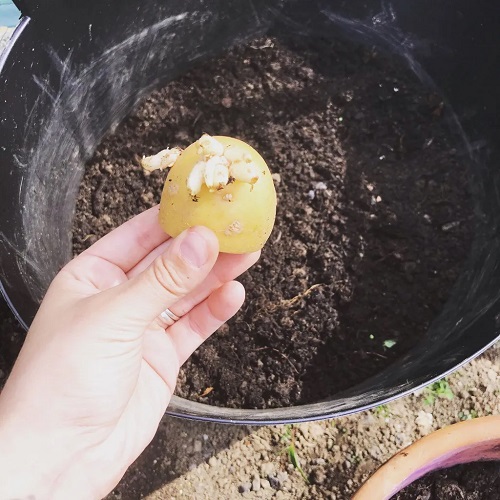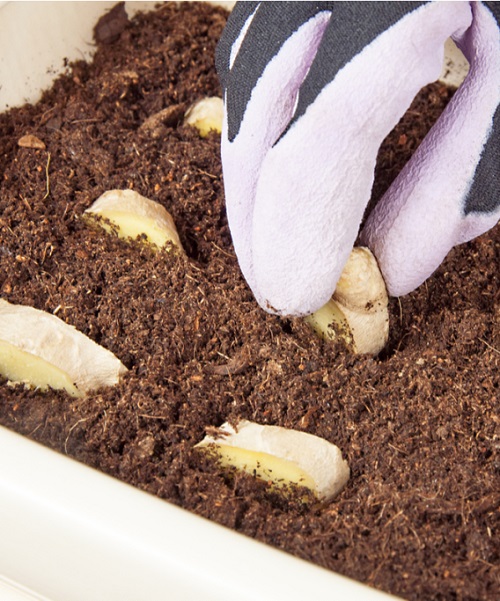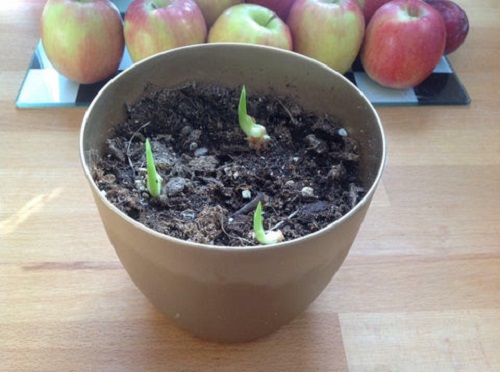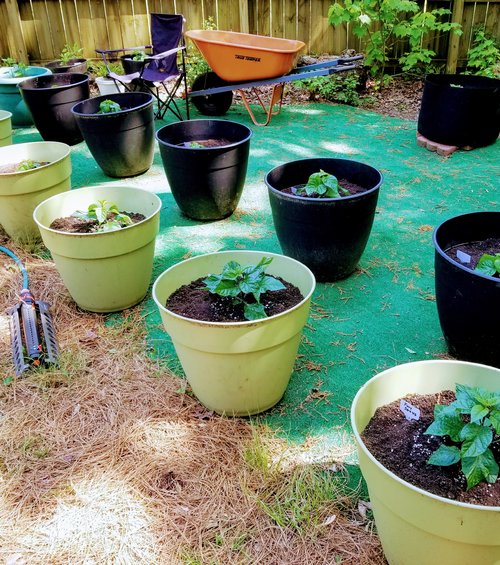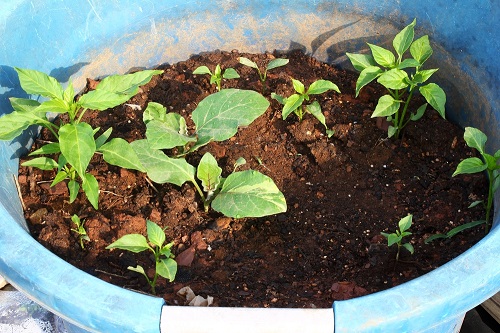Here’s a list of the Vegetables that Grow Many from One that you can use to multiply easily for plenty of harvest for the entire family!
What could be a better way to maximise the harvest than opting for Vegetables that Grow Many from One? These super greens are easy to grow and multiply in no time!
Read about 12 Vegetables You Should Never Plant Together and Why here
Vegetables that Grow Many from One
1. Garlic

A single garlic head consists of multiple cloves. But did you know that each clove can be planted individually to grow a new garlic plant? First on the list of Vegetables that Grow Many from One – this one is a must have in your garden!
How to Do It: Separate the cloves from the garlic head. Plant each clove, pointed end up, about 2 inches deep in well-draining soil. Space them about 4-6 inches apart.
In a few weeks, cloves will sprout and develop into new garlic plants.
2. Onions
Onions are also among Vegetables that grow many from one as they can be propagated from sets or bulbs. Each set can produce a new onion plant.
How to Do It: Plant onion sets or bulbs in the soil, burying them just deep enough to cover them. Space them according to the recommended spacing for the specific onion variety. As the sets grow, they’ll produce new onion bulbs, giving you unlimited onions.
How to Grow Unlimited Supply of Onions in Big Plastic Bottles at Home
3. Shallots

Similar to onions, shallots can also be propagated from sets or bulbs. Each set can grow into a new shallot plant, so you can relish these as much as you want!
How to Do It: Plant shallot sets or bulbs in well-draining soil, leaving the tip exposed. Space them based on recommendations for the shallot variety, and voila! Each set will produce a cluster of shallots.
4. Potatoes
Potatoes are amazing Vegetables that grow many from one. They can be propagated from “seed potatoes,” which are whole or cut potato pieces with at least one “eye” or sprout.
How to Do It: Cut seed potatoes into pieces, ensuring each piece has at least one eye. Allow the cut pieces to air dry for a day to prevent rotting.
Plant them in soil, eyes facing upward. Continue to provide proper care, and in a few weeks, they’ll produce new potatoes.
5. Ginger
Can’t have enough of Ginger as a culinary delight? Ginger can be propagated from a single piece, called a “rhizome,” easily if you want to grow many from one.
How to Do It: Plant a ginger rhizome in well-draining soil with the buds facing upward. Keep the soil consistently moist. As the rhizome grows, it will produce new shoots and roots.
How to Grow Many Ginger Plants from One Ginger | Ginger Propagation
6. Turmeric
Just like Ginger, Turmeric are also Vegetables that grow many from one and are easily multiplied by rhizomes.
How to Do It: Plant a turmeric rhizome in a warm, well-draining soil mix with the buds facing upward. Maintain consistent moisture. New shoots and leaves will emerge from the rhizome.
7. Jerusalem Artichokes (Sunchokes)

Jerusalem artichokes can be propagated from tubers. And that, too, in just 2-4 weeks!
How to Do It: Plant Jerusalem artichoke tubers in loose soil, about 4-6 inches deep. Space them according to the plant’s growth habits. The tubers will sprout and produce tall plants with edible tubers.
8. Tomatoes
Tomatoes are a prime candidate on our list of Vegetables that grow many from one. The juicy pulp contains seeds that hold the promise of new plants.
How to Do It: Gently scoop out the seeds and pulp from a ripe tomato. Place them in a container and add water. Allow the mixture to ferment for a few days. The good seeds will sink to the bottom. Rinse and dry these seeds before planting.
Plant the seeds in pots or trays filled with seed-starting mix. Keep them warm and moist as they germinate and grow. Once seedlings are established, transplant them outdoors or into larger pots.
Find out the best ways of propagating tomatoes here
9. Peppers
Peppers are also on our Vegetables that grow many from one list and offer the potential for propagation through their seeds, found within the fleshy fruit.
How to Do It: Cut open a mature pepper and carefully remove the seeds. Rinse and dry the seeds thoroughly. Plant them in seed trays or pots filled with seed-starting mix.
Cover them lightly with soil and keep them warm and consistently moist. As the seedlings develop, transplant them to larger containers or your garden beds.
10. Eggplants
Eggplants, like tomatoes and peppers, have seeds nestled within their flesh that you can use to multiply these savory vegetables.
How to Do It: Slice open a ripe eggplant and extract the seeds along with the surrounding pulp. Place the seeds and pulp in a container of water and let it sit for a couple of days. The viable seeds will settle at the bottom.
Rinse and dry these seeds before planting. Sow them in pots or trays with well-draining soil. Maintain warmth and moisture for successful germination. Once seedlings are strong, transplant them outdoors or into larger containers.
11. Squash and Cucumbers

How can we skip squash and cucumber when talking about Vegetables that grow many from one? You can extract their seeds from the flesh for propagation.
How to Do It: Cut open a ripe squash or cucumber, and remove the seeds along with the surrounding pulp. Wash and dry the seeds thoroughly.
Plant them in well-prepared soil or containers. Ensure consistent moisture and warmth for germination. Once they’ve sprouted and grown, transplant the seedlings to their designated spots.
Unique Ways to Grow Cucumbers
12. Melons
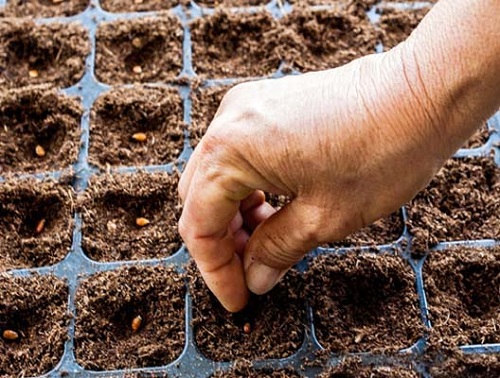
A fan of melons? Melons can also be propagated through their seeds, found in the heart of the delicious fruit.
How to Do It: Scoop out the seeds from a ripe melon. Rinse and clean the seeds, removing the excess pulp. Allow them to dry completely.
Plant the seeds in well-draining soil, either in pots or directly in the garden. Provide adequate water and care as the seedlings emerge and grow.
13. Sweet Potatoes
Sweet potatoes can be grown from “slips,” which are sprouts that emerge from a sweet potato. And each slip grows into a whole new sweet potato.
How to Do It: Place sweet potatoes in a jar of water with toothpicks supporting them partially submerged. When slips form, gently twist them off, making sure each slip has several inches of growth.
Transfer these slips into pots filled with well-draining soil and allow them to establish roots before transplanting them into your garden.
14. Lettuce
Lettuce can be regrown from its stem base. So the next time you harvest Lettuce, put these to good use instead of throwing them away.
How to Do It: Place the stem base in a container with water, ensuring the bottom is submerged, and the top foliage is above the water level.
Change the water regularly to prevent stagnation. Once the new leaves have grown sufficiently, transplant the young lettuce plant into your garden, providing it with proper spacing for continued growth.
How to Harvest Lettuce So that It Keeps Growing | Lettuce Harvesting Tips
15. Celery
Celery are Vegetables that grow many from one as they can be regenerated from the base. Rather than tossing the base, you can use it to grow a fresher one.
How to Do It: Place the celery base in a container with water, make sure the bottom is submerged, and leave the top foliage exposed. Change the water every few days to maintain freshness.
As new shoots emerge from the center, transplant the celery into nutrient-rich soil, ensuring the base is below the surface and allowing it to thrive in your garden.
These vegetables have the unique ability to regenerate from a single unit, providing you with a continuous supply of fresh produce. By following the proper planting techniques, you can enjoy multiple plants from just one original head or piece.
Bonus – Herbs that Grow Many from One
Did you know that there are also many Herbs that grow many from one? Yes, you read that right! Basil, mint, cilantro, and other herbs can be grown from their cuttings.
Here’s how to do it. First, cut a stem that’s around 4-6 inches long, making sure to remove the lower leaves. Then, place the stem in a glass of water, making sure that the remaining leaves are well above the water level.
Here are the best ways to preserve herbs after harvesting them
After a week or so, roots will begin to grow from the submerged end of the stem. Once the roots are well established, the cuttings can be transplanted into containers or directly into your garden soil.
Vegetables that Grow Many from One – Conclusion
By mastering the art of propagation, you can transform a solitary garlic clove, a lone potato piece, or a solitary ginger rhizome into a thriving garden of flavorful produce. With a little patience and care, your garden will become a renewable source of wholesome goodness full of these Vegetables that grow many from one.
So, don your gardening gloves, dig in the soil, and enjoy the satisfaction of watching your one become many, all while relishing the fruits (and vegetables) of your labor.
Vegetables that Grow Many from One – FAQs
1. Why Should I Consider Vegetables That Grow Many From One?
Growing these vegetables not only saves money but also reduces waste. It’s an eco-friendly way to enjoy fresh produce and maximize your garden’s potential.
2. Can I Grow These Vegetables Indoors?
Yes, many of these vegetables can be grown indoors in pots or containers, provided they receive adequate light and care.
3. How Long Does It Take for These Vegetables to Regrow?
The time varies depending on the vegetable and growing conditions. Typically, you can expect to see significant growth within a few weeks to a few months.
Man Made Vegetables You Never Knew About!
4. Can I Grow These Vegetables From Store-Bought Produce?
Yes, you can often use store-bought vegetables, such as potatoes or ginger, to start your garden. Just make sure they are healthy and haven’t been treated to prevent sprouting.
5. What Is the Best Time to Plant These Vegetables?
Timing varies by vegetable and location. Generally, plant them during the appropriate growing season for your region, following the recommendations for each specific type.


